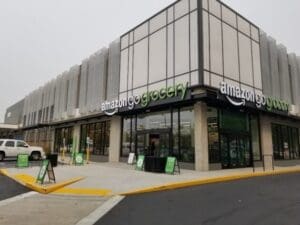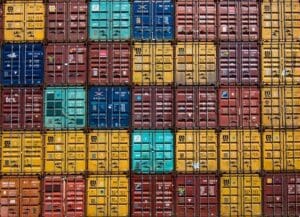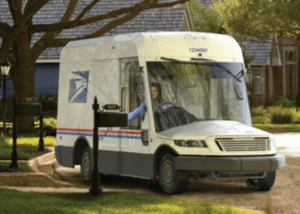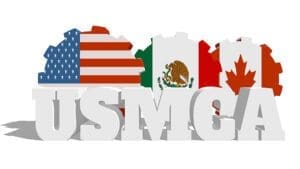 Sometimes when a company has too many similar options it can cause a lot of confusion. This appears to be the case for Amazon as it has expanded its grocery options over the years. For Amazon customers, things could certainly be a bit overwhelming as they tried to decipher the difference between Amazon Go, Amazon Go Grocery, Amazon Fresh grocery stores, Amazon Fresh delivery, Whole Foods delivery, and Prime Now delivery. So, the company is working to simplify things, at least a little bit. Amazon is renaming its Amazon Go Grocery brand to “Amazon Fresh” and closing its Amazon Go Grocery store in Redmond, WA. The other Amazon Go Grocery store in Seattle’s Capitol Hill neighborhood will remain open and be called “Amazon Fresh.” Although, there are still a lot of moving parts here that can cause brand confusion, especially with its grocery delivery services. It will be interesting to see if Amazon simplifies things a bit more in the near future. And now on to this week’s logistics news.
Sometimes when a company has too many similar options it can cause a lot of confusion. This appears to be the case for Amazon as it has expanded its grocery options over the years. For Amazon customers, things could certainly be a bit overwhelming as they tried to decipher the difference between Amazon Go, Amazon Go Grocery, Amazon Fresh grocery stores, Amazon Fresh delivery, Whole Foods delivery, and Prime Now delivery. So, the company is working to simplify things, at least a little bit. Amazon is renaming its Amazon Go Grocery brand to “Amazon Fresh” and closing its Amazon Go Grocery store in Redmond, WA. The other Amazon Go Grocery store in Seattle’s Capitol Hill neighborhood will remain open and be called “Amazon Fresh.” Although, there are still a lot of moving parts here that can cause brand confusion, especially with its grocery delivery services. It will be interesting to see if Amazon simplifies things a bit more in the near future. And now on to this week’s logistics news.
- Echoing Amazon: Walmart and Target try local package delivery
- Port of Oakland sets all-time cargo record
- West coast ports race to clear ship backlog by August
- Oshkosh Defense receives USPS multi-billion-dollar contract
- EU suspends plans to raise tariffs on US whisky, other goods
- US, Canada, Mexico hold ‘robust’ trade deal talks, downplay differences
- Ford redesigning parts to use more accessible chips
- AT&T, Verizon make separate asset tracking moves
- BC introduces weight allowances for battery-electric trucks and fuel cells
 The e-commerce boom is continuing to put a strain on parcel delivery companies like UPS, FedEx, and the USPS. As a result, more retailers are looking to take delivery matters into their own hands. Taking a page from their biggest rival, Walmart and Target are testing their own home package delivery services in the US. Walmart has been testing its first company-branded “last-mile” delivery vans for the last few months using a small, electric van fleet. The service has made package deliveries in the Bentonville and Rogers areas near Walmart’s Arkansas headquarters. Target is relying on Shipt, the home delivery service it acquired in 2017. The retailer began testing home package delivery from a new sorting center in its hometown of Minneapolis earlier this year. Workers in the sorting center group packages by zone and hand some of them over to Shipt drivers, who use their own cars for deliveries.
The e-commerce boom is continuing to put a strain on parcel delivery companies like UPS, FedEx, and the USPS. As a result, more retailers are looking to take delivery matters into their own hands. Taking a page from their biggest rival, Walmart and Target are testing their own home package delivery services in the US. Walmart has been testing its first company-branded “last-mile” delivery vans for the last few months using a small, electric van fleet. The service has made package deliveries in the Bentonville and Rogers areas near Walmart’s Arkansas headquarters. Target is relying on Shipt, the home delivery service it acquired in 2017. The retailer began testing home package delivery from a new sorting center in its hometown of Minneapolis earlier this year. Workers in the sorting center group packages by zone and hand some of them over to Shipt drivers, who use their own cars for deliveries.
 The Port of Oakland reached a milestone in April, setting an all-time record for cargo handling. For the first time in its history, the port handled more than 100,000 import containers in a single month. Overall volume through the port rose 8 percent in April, and imports climbed 25 percent year-over-year to 100,096 twenty-foot-equivalent units (TEUs). Officials said the US economic rebound and a resulting demand for Asian imports is driving the strong results. April marked the third consecutive month of import gains, and the second straight record month. Overall import volume has increased 19 percent year-to-date. Export volume fell 3.7 percent compared to a year ago, driven partly by demand for empty containers.
The Port of Oakland reached a milestone in April, setting an all-time record for cargo handling. For the first time in its history, the port handled more than 100,000 import containers in a single month. Overall volume through the port rose 8 percent in April, and imports climbed 25 percent year-over-year to 100,096 twenty-foot-equivalent units (TEUs). Officials said the US economic rebound and a resulting demand for Asian imports is driving the strong results. April marked the third consecutive month of import gains, and the second straight record month. Overall import volume has increased 19 percent year-to-date. Export volume fell 3.7 percent compared to a year ago, driven partly by demand for empty containers.
 West coast port congestion is certainly nothing new. Over the last few months, the number of ships that have been anchored outside of ports has slowly decreased. Thankfully the ship congestion that has been plaguing these ports is beginning to signs of easing as port officials race to clear a backlog of arriving cargo before peak season begins in about three months. A total of 19 container ships were anchored waiting for entry into Los Angeles and Long Beach as of Sunday, compared with 21 a week earlier, and a peak of around 40 vessels in early February. The average wait for berth space was 6.1 days, compared with 6.6 a week ago, according to the LA port. That number had peaked around 8 days in April. The goal is to have few, if any, ships needing to wait by June 1, ensuring that the ports are ready for the August import crunch.
West coast port congestion is certainly nothing new. Over the last few months, the number of ships that have been anchored outside of ports has slowly decreased. Thankfully the ship congestion that has been plaguing these ports is beginning to signs of easing as port officials race to clear a backlog of arriving cargo before peak season begins in about three months. A total of 19 container ships were anchored waiting for entry into Los Angeles and Long Beach as of Sunday, compared with 21 a week earlier, and a peak of around 40 vessels in early February. The average wait for berth space was 6.1 days, compared with 6.6 a week ago, according to the LA port. That number had peaked around 8 days in April. The goal is to have few, if any, ships needing to wait by June 1, ensuring that the ports are ready for the August import crunch.
 Oshkosh Defense, a contractor largely known for producing rugged, tactical vehicles normally found in warzones, was selected in February 2021 to receive the US Postal Service’s multi-billion-dollar contract for crafting the Next Generation Delivery Vehicle fleet over the next 10 years. The average USPS vehicle is 25 years old, with some vehicles purchased as long ago as 1987, meaning that the agency relies on a lifecycle far longer than most commercial drivers expect. According to Oshkosh Defense President John Bryant, the needs of mail carriers for those new vehicles are centered on a truck that can keep going no matter what. The vehicles will include USPS-specific needs such as all wheel drive, larger cargo areas for package delivery, much greater bumper visibility, and better ergonomics for right-side driving and delivery.
Oshkosh Defense, a contractor largely known for producing rugged, tactical vehicles normally found in warzones, was selected in February 2021 to receive the US Postal Service’s multi-billion-dollar contract for crafting the Next Generation Delivery Vehicle fleet over the next 10 years. The average USPS vehicle is 25 years old, with some vehicles purchased as long ago as 1987, meaning that the agency relies on a lifecycle far longer than most commercial drivers expect. According to Oshkosh Defense President John Bryant, the needs of mail carriers for those new vehicles are centered on a truck that can keep going no matter what. The vehicles will include USPS-specific needs such as all wheel drive, larger cargo areas for package delivery, much greater bumper visibility, and better ergonomics for right-side driving and delivery.
 The ongoing trade war between the US and the EU is taking a quick pause as EU officials are set to begin talks with the Biden administration aimed at lifting US steel tariffs. That pause means that the EU has agreed to postpone plans to raise tariffs on American whiskeys, motorcycles, boats, and other items set to take effect June 1. In a joint statement, the US and EU said they would begin formal discussions to address problems plaguing the global steel and aluminum industry, and “agreed to chart a path” toward resolving the dispute that led to tariffs. They said the talks would include discussions on how overproduction in China depresses prices and threatens the viability of domestic metal producers.
The ongoing trade war between the US and the EU is taking a quick pause as EU officials are set to begin talks with the Biden administration aimed at lifting US steel tariffs. That pause means that the EU has agreed to postpone plans to raise tariffs on American whiskeys, motorcycles, boats, and other items set to take effect June 1. In a joint statement, the US and EU said they would begin formal discussions to address problems plaguing the global steel and aluminum industry, and “agreed to chart a path” toward resolving the dispute that led to tariffs. They said the talks would include discussions on how overproduction in China depresses prices and threatens the viability of domestic metal producers.
 Speaking of foreign trade, the US, Canada, and Mexico held “robust” talks on the new North American trade deal and pledged to fully enforce its higher standards, while downplaying differences over a range of other irritants. The ministers, in a joint statement issued after their first meeting to review the US-Mexico-Canada Agreement on trade that took effect in July 2020, also vowed to focus on fighting climate change and crack down on imports of goods to the region made with forced labor. Their statement described discussions on new labor and environmental obligations as “robust.” The USMCA replaced the 1994 North American Free Trade Agreement, adding chapters on environmental, labor and digital commerce standards and considerably tighter regional automotive content rules.
Speaking of foreign trade, the US, Canada, and Mexico held “robust” talks on the new North American trade deal and pledged to fully enforce its higher standards, while downplaying differences over a range of other irritants. The ministers, in a joint statement issued after their first meeting to review the US-Mexico-Canada Agreement on trade that took effect in July 2020, also vowed to focus on fighting climate change and crack down on imports of goods to the region made with forced labor. Their statement described discussions on new labor and environmental obligations as “robust.” The USMCA replaced the 1994 North American Free Trade Agreement, adding chapters on environmental, labor and digital commerce standards and considerably tighter regional automotive content rules.
 A few months ago I wrote about the semiconductor shortage and the impact on the automotive industry. In response to this shortage, Ford Motor Co. announced it is redesigning automotive components to use more accessible chips. The chip shortage has caused automakers globally to curtail production. Last month, Ford said the issue would cost it $2.5 billion this year and halve its vehicle production in the second quarter, when the shortage will be at its worst. Ford said it is weighing other strategies for the future, including building a buffer supply of chips and signing supply deals directly with the foundries that make the wafers used in semiconductors. Normally, automakers get their chips suppliers, not direct from the foundries.
A few months ago I wrote about the semiconductor shortage and the impact on the automotive industry. In response to this shortage, Ford Motor Co. announced it is redesigning automotive components to use more accessible chips. The chip shortage has caused automakers globally to curtail production. Last month, Ford said the issue would cost it $2.5 billion this year and halve its vehicle production in the second quarter, when the shortage will be at its worst. Ford said it is weighing other strategies for the future, including building a buffer supply of chips and signing supply deals directly with the foundries that make the wafers used in semiconductors. Normally, automakers get their chips suppliers, not direct from the foundries.
Asset tracking is becoming big business and is incredibly important for many industries. Now, AT&T and Verizon have both launched their own connected equipment to track high-value assets. AT&T worked with Sony Semiconductor Israel to create an adhesive label which connects to the operator’s LTE-M network and sends data to the cloud to enable decisions while packages are in transit. The connection activates when the label is attached to a package. Verizon created an asset tracker device for customers of its Connect Reveal fleet management software. The compact connected device can be installed by customers and is suitable for generators, trailers, storage containers and other equipment. The device works with Verizon’s Connect Spotlight app and has a replaceable battery.
As truck manufacturers make the commitment to cleaner technology upgrades, British Columbia is making low-emission options more affordable for the trucking companies and drivers Specifically, British Columbia is offsetting some of the heavier weights associated with battery-electric trucks and equipment that runs on fuel cells. A 1,500 kg weight allowance is being introduced for full-sized electric commercial vehicles, while a 1,000 kg allowance is being offered for those with fuel cells. Maximum gross combination vehicle weights rise to a respective 65,000 and 64,500 kg. The changes align with allowances already made for trucks and buses that run on liquified natural gas (LNG) and compressed natural gas (CNG), the province says. Initial allowances will be made available through letters of authorization. And after a 90-day notice period, CNG, LNG and LNG/diesel bi-fueled vehicles will also require such letters.
That’s all for this week. Enjoy the weekend and the song of the week, Land of Confusion by Genesis.

















